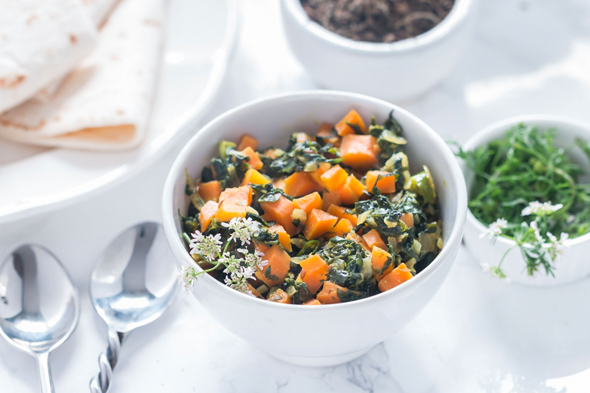Mama’s Punjabi Recipes: Gajjar Methi (Sauteed Carrots and Fenugreek)
Punjabis love carrots in several ways, but seldom cooked alone –unless it’s halwa -as no matter what spice you add, the dish comes out too sweet and doesn’t go with any type of roti. There are at least three ingredients that can be accompaniments to tame that sweetness: mutter (peas) or methi (fenugreek) or wadiyan (spiced dumplings), as well as the right blend of spices. Some restaurants use packages of precut mixed carrots, corn and peas or lima beans to make a slightly sweet, creamy curry, but this is out of convenience and not a traditional recipe.
Methi is a plant with three small oblong leaflets that is grown in many countries around the world in semi-arid climates, especially in South Asia. It is grown all across western and northern India, with Rajasthan alone producing 80% of India’s output. Methi is high in carbohydrates, protein and minerals. It is also used, since ancient times, in medicinal home remedies to soothe digestive problems, control blood sugar and reduce diabetes as well as cholesterol.
Methi leaves are removed from the stems and relished for their bitterness and aroma that adds extra flavor to the foods they are mixed with but since it is labor intensive to pick the leaves and wash them thoroughly to get rid of the dirt, many people prefer to buy dried picked leaves in sealed packets. When dried, methi can also be used as a spice for flavoring other dishes.
Methi is used in making pickles, daals (lentils), paranthas and vegetable dishes, like the Punjabi dish, aaloo methi (sautéed potatoes and fenugreek). When cooked with carrots, methi coats them and cuts back the sweet taste enough to add proper flavor. It’s not necessary to use pyaaz (onion), lasan (garlic) or adrak (ginger) when cooking as methi has its own, unique strong taste.
Ingredients:
500 gm gajjar (carrots)
1 kg methi (fenugreek) – fresh is best
2 tablespoons of vegetable or olive oil
Spices (to taste): namak (salt), mirch (red pepper), haldi (turmeric), garam masala
Directions:
1. Pick the methi off the stems and place in a strainer. Wash thoroughly in cold water in get out any dirt and leave in the strainer to drip dry for a while. When slightly dry, chop into small pieces.
2. Peel the carrots, cut off the tips and stalks and chop into 2 cm wide disks. You can also cut into short stems if you like, but the chips have less sharp edges. Place in a wide bowl, wash them and let them soak in cold water.
3. Heat 2 tablespoons of oil in a kadai or wok over medium heat, then add the salt, pepper and haldi and stir well.
4. Drain the water from the cut carrots and throw them into the spices. Add the methi and stir well to coat. Cover and let them cook for 5 minutes.
5. Check to see if the carrots have become tender, stir and let cook for another 5 minutes over low heat.
6. Turn off the heat, stir and leave uncovered for a few minutes. Before serving, garnish the dish with garam masala.
MAMA’S TIP OF THE WEEK
COOKED CARROTS SHOULD BE FIRM, NOT MUSHY
Cooking with carrots can be tricky as they have so much water of their own that often the dish you are making can come out mushy. The carrots can simply crumble if left covered too long and under lots of stirring. Some kinds of carrots, like baby carrots, are better eaten raw and not suitable for cooking as a dish. Even when making halwa, carrots must taste firm and not mushy.
When sautéing in dishes, it is important to stir the carrots gently and then leaving them uncovered to let the steam run off. In fact, some people even prefer to cook the carrots alone first under medium high heat to make them really brown and dry before adding other ingredients.

Shakuntla Malhotra is a skilled cook of Punjabi dishes made in the old-fashioned style that she learnt as a young woman in her ancestral home in Lyallpur (since renamed Faisalabad), India before it became part of Pakistan after the Partition in 1947. People have often admired her cooking for its simplicity and taste that comes with each mouthful. Even in her mid-eighties, she continues to cook daily and agreed to share some of her delectable Punjabi recipes.

